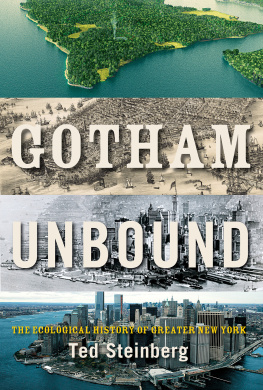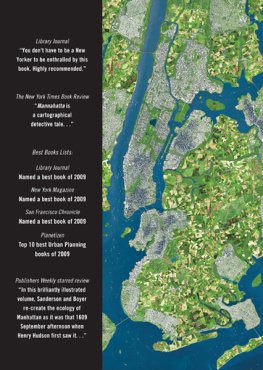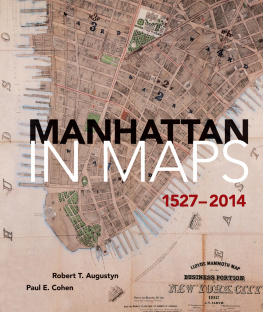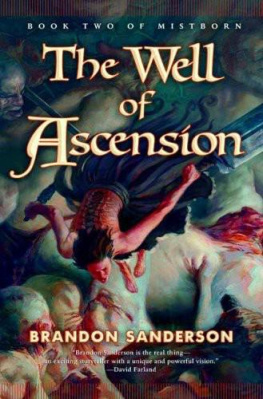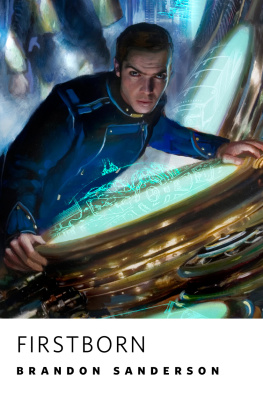Mannahatta: A Natural History of New York City is the revelation, in words and pictures, of a quiet, wooded island at the mouth of a great river, with a temperate climate and a gentle and enduring people, destined to become one of the greatest cities on Earth. The explorer Henry Hudson was looking for Oriental riches when he came to Manhattan Islands shore on September 12, 1609, but instead he found something much more valuable. Mannahatta, the island of many hills, was home to over fifty-five different ecosystems, with thousands of species (including wolves, black bears, bald eagles, passenger pigeons, and sea-run trout) thriving in a landscape shaped over the millennia, an example of the abundance and diversity of nature undiminished by the human footprint.
Eric Sanderson is a landscape ecologist with the Wildlife Conservation Society, and this book culminates ten years of primary research into the ecological history of ManhattanThe Mannahatta Project. Sanderson and his colleagues have reconstructed Mannahatta at the scale of a city block using the latest techniques in computational geography and visualization that allow them to re-create what Manhattan looked like in the hours before Hudson arrived. The story of the projects creation touches on George Washington and the American Revolution; the original Native American people, the Lenape, who lived on Mannahatta; the remarkable hills, streams, and dales of a lost landscape; and the new science of Muir webs, which describe the interconnections that make nature and cities work.
More than a history, Mannahatta: A Natural History of New York City is a call for us to stretch our imaginations not just back to 1609, but ahead to cities and a world where people and wildlife can thrive for hundreds of years into the future.

Mannahatta


Editor: Deborah Aaronson
Designer: Abbott Miller and Christine Moog/Pentagram Design Inc.
Production Manager: Anet Sirna-Bruder
Library of Congress Cataloging-in-Publication Data
Sanderson, Eric W.
Mannahatta: a natural history of New York City / by Eric W. Sanderson; illustrations by Markley Boyer.
p. cm.
ISBN 978-0-8109-9633-5 (Harry N. Abrams, Inc.)
1. Natural historyNew York (State)New York. I. Title.
QH105.N7S26 2009
508.7471dc22
2008042042
Copyright 2009 Eric W. Sanderson
Published in 2009 by Abrams, an imprint of Harry N. Abrams, Inc. All rights reserved. No portion of this book may be reproduced, stored in a retrieval system, or transmitted in any form or by any means, mechanical, electronic, photocopying, recording, or otherwise, without written permission from the publisher.
Abrams books are available at special discounts when purchased in quantity for premiums and promotions as well as fundraising or educational use. Special editions can also be created to specification. For details, contact specialmarkets@hnabooks.com or the address below.

115 West 18th Street
New York, NY 10011
www.abramsbooks.com
: Manhattan, circa 1609 and 2009.
This book was supported by Furthermore: a program of the J. M. Kaplan Fund.
To Mom and Dad
I was asking for something specific and perfect for my city,
Whereupon lo! upsprang the aboriginal name.
Now I see what there is in a name, a word, liquid, sane, unruly, musical, self-sufficient,
I see that the word of my city is that word from old
Walt Whitman, Mannahatta,
Leaves of Grass 189192
Chapter One
The Mannahatta Project
Chapter Two
A Map Found
Chapter Three
The Fundamentals of Mannahatta
Chapter Four
The Lenape
Chapter Five
Ecological Neighborhoods
Chapter Six
Muir Webs: Connecting the Parts
Chapter Seven
Manhattan 2409

Mannahatta, 1609.
Chapter One
The Mannahatta Project
As the moon rose higher the inessential houses began to melt away until gradually I became aware of the old island here that flowered once for Dutch sailors eyesa fresh, green breast of the new world. Its vanished trees had once pandered in whispers to the last and greatest of all human dreams; for a transitory enchanted moment man must have held his breath in the presence of this continent, compelled into an aesthetic contemplation he neither understood nor desired, face to face for the last time in history with something commensurate to his capacity for wonder.
F. Scott Fitzgerald, The Great Gatsby 1925
On a hot, fair day, the twelfth of September, 1609, Henry Hudson and a small crew of Dutch and English sailors rode the flood tide up a great estuarine river, past a long, wooded island at latitude 4048 north, on the edge of the North American continent. Locally the island was called Mannahatta, or Island of Many Hills. One day the island would become as densely filled with people and avenues as it once was with trees and streams, but not that afternoon. That afternoon the island still hummed with green wonders. New York City, through an accident, was about to be born.
Hudson, an English captain in Dutch employ, wasnt looking to found a city; he was seeking a route to China. Instead of Oriental riches, what he found was Mannahattas natural wealththe old-growth forests, stately wetlands, glittering streams, teeming waters, rolling hills, abundant wildlife, and mysterious people, as foreign to him as he was to them. The landscape that Hudson discovered for Europe that day was prodigious in its abundance, resplendent in its diversity, a place richer than many people today imagine could exist anywhere. If Mannahatta existed today as it did then, it would be a national parkit would be the crowning glory of American national parks.
Mannahatta had more ecological communities per acre than Yellowstone, more native plant species per acre than Yosemite, and more birds than the Great Smoky Mountains National Park. Mannahatta housed wolves, black bears, mountain lions, beavers, mink, and river otters; whales, porpoises, seals, and the occasional sea turtle visited its harbor. Millions of birds of more than a hundred and fifty different species flew over the island annually on transcontinental migratory pathways; millions of fishshad, herring, trout, sturgeon, and eelswam past the island up the Hudson River and in its streams during annual rites of spring. Sphagnum moss from the North and magnolia from the South met in New York City, in forests with over seventy kinds of trees, and wetlands with over two hundred kinds of plants. Thirty varieties of orchids once grew on Mannahatta. Oysters, clams, and mussels in the billions filtered the local water; the river and the sea exchanged their tonics in tidal runs and freshets fueled by a generous climate; and the entire scheme was powered by the moon and the sun, in ecosystems that reused and retained water, soil, and energy, in cycles established over millions of years.
Next page




